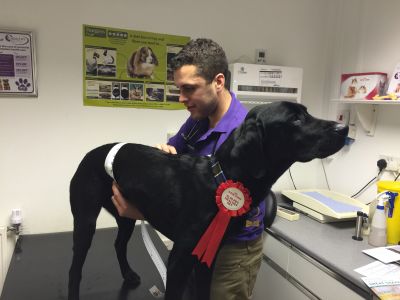
Posted By:
January is a time of year filled with resolutions and good intentions for healthy eating plans and new exercise regimes. Most of us are aware of the importance of these for our own health and well-being but the importance for our pets is often overlooked. We frequently feed them treats, titbits and left overs often without appreciating how much extra food they are actually being given. This can have an unintentional and detrimental effect on their weight. The incidence of obesity in our pet dogs, cats, and rabbits has been steadily increasing over the last few years. A PDSA study in 2015 showed 1 in 3 dogs and 1 in 4 cats are overweight or obese. These figures are quite frightening given the impact this can have on our pets’ health.
There are a number of serious health conditions that occur more frequently in overweight pets, such as diabetes, heart disease, breathing problems and high blood pressure. Also additional weight through a pet’s joints will lead to mobility problems. This is particularly crucial in patients who have arthritis. It can become a vicious circle with weight gain leading to a reduced ability to exercise which further worsens their weight problem thus leading to a further decrease in their capacity to exercise. This all leads to additional risk of other health problems.
The first stage in addressing the problem is being able to tell whether our pet is overweight. This can be a difficult task; however there are some good guides to help us. The best way is body condition scoring. This is usually done on a 1-9 scale, with 1 being very skinny and 9 being very obese. A number 4 or 5 is the ideal. At 4-5 on the scale you cannot see the animals ribs but can feel them if you gently run your hands over them. They should also have an obvious waist when you look at them from above. Once you have got used to feeling these things, noticing whether your pet is overweight becomes a lot easier.
Once we are aware that our animal is overweight we can go about changing things. Firstly, we need to determine an animal’s ideal body weight, how much they need to lose and over what timescale this loss should take place. We look at their current body condition score and how heavy they are to determine this. We then have to regularly assess them once they are getting near their target weight to determine whether it is correct.
The process of losing weight begins with getting an accurate picture of what is currently being fed. This often includes a lot of extras alongside their normal biscuit or wet food. Small changes such as cutting out the extras, weighing food to be sure it is the correct amount and ensuring that they have enough exercise can all make a huge difference. Making sure that the food being fed is a good quality one also helps. For some pets where making them lose weight is a little more difficult, there are special diets to help. Some of these diets are designed to allow a large amount of food to be eaten but this has lower calorie intake than the same amount of other diets. This can help your pet to feel fuller for longer and hopefully stop them begging for more food!
It can feel like a long road, getting them to their ideal weight, but there is a lot of support available. Here at the surgery we offer free weight clinics where our nurses will be able to give guidance as to whether your pet is overweight, how much they need to lose and how to go about it. Most people come in for monthly checks to assess progress and seeing the improvement in our pet’s health, as they lose the weight, is incredibly rewarding. They look sleeker, happier and we know they will be reaping the health benefits.
As our feline friends get older there are a few conditions...
Another winter discussion group season is now behind...
We used a client’s new Morris Remote Control...
Itchy and sore skin is a common issue amongst our...
©2024 Shepton Veterinary Group Ltd., All rights reserved.
Privacy Policy • Terms & Conditions • Cookie Policy